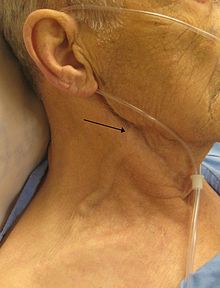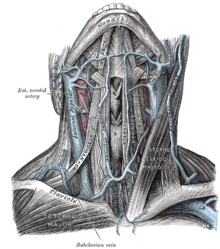- Jugular venous pressure
-
The jugular venous pressure (JVP, sometimes referred to as jugular venous pulse) is the indirectly observed pressure over the venous system. It can be useful in the differentiation of different forms of heart and lung disease. Classically three upward deflections and two downward deflections have been described.
- The upward deflections are the "a" (atrial contraction), "c" (ventricular contraction and resulting bulging of tricuspid into the right atrium during isovolumetric systole) and "v" = atrial venous filling.
- The downward deflections of the wave are the "x" (the atrium relaxes and the tricuspid valve moves downward) and the "y" descent (filling of ventricle after tricuspid opening).
Contents
Method
Visualization
The patient is positioned under 45°, and the filling level of the jugular vein determined. Visualize the internal jugular vein when looking for the pulsation. In healthy people, the filling level of the jugular vein should be less than 3 centimetres vertical height above the sternal angle. A pen-light can aid in discerning the jugular filling level by providing tangential light.
The JVP is easiest to observe if one looks along the surface of the sternocleidomastoid muscle, as it is easier to appreciate the movement relative to the neck when looking from the side (as opposed to looking at the surface at a 90 degree angle). Like judging the movement of an automobile from a distance, it is easier to see the movement of an automobile when it is crossing one's path at 90 degrees (i.e. moving left to right or right to left), as opposed to coming toward one.
Pulses in the JVP are rather hard to observe, but trained cardiologists do try to discern these as signs of the state of the right atrium.
Differentiation from the carotid pulse
The JVP and carotid pulse can be differentiated several ways:
- multiphasic - the JVP "beats" twice (in quick succession) in the cardiac cycle. In other words, there are two waves in the JVP for each contraction-relaxation cycle by the heart. The first beat represents that atrial contraction (termed a) and second beat represents venous filling of the right atrium against a closed tricuspid valve (termed v) and not the commonly mistaken 'ventricular contraction'. These wave forms may be altered by certain medical conditions therefore this is not always an accurate way to differentiate the JVP from the carotid pulse. The carotid artery only has one beat in the cardiac cycle.
- non-palpable - the JVP cannot be palpated. If one feels a pulse in the neck, it is generally the common carotid artery.
- occludable - the JVP can be stopped by occluding the internal jugular vein by lightly pressing against the neck. It will fill from above.
- varies with head-up-tilt (HUT) - the JVP varies with the angle of neck. If a person is standing, his JVP appears to be lower on the neck (or may not be seen at all because it is below the sternal angle). The carotid pulse's location does not vary with HUT.
- varies with respiration - the JVP usually decreases with deep inspiration. Physiologically, this is a consequence of the Frank–Starling mechanism as inspiration decreases the thoracic pressure and increases blood movement into the heart (venous return), which a healthy heart moves into the pulmonary circulation.
JVP waveform
 Jugular venous pulse
Jugular venous pulse
The jugular venous pulsation has a biphasic waveform.
- The 'a' wave corresponds to atrial contraction and ends synchronously with the carotid artery pulse. The peak of the 'a' wave demarcates the end of atrial systole.
- The 'c' wave occurs when the ventricles begin to contract causing the atrioventricular (AV) valves to bulge towards the atria.
- The 'x' descent follows the 'a' wave and represents atrial relaxation and rapid atrial filling due to low pressure. The 'x' ' (x prime) descent follows the 'c' wave and occurs as a result of the right ventricle pulling the tricuspid valve downward during ventricular systole. The 'x' ' (x prime) descent can be used as a measure of right ventricle contractility.
- The 'v' wave is seen when the tricuspid valve is closed and is caused by a pressure increase in the atrium as the venous return fills the atria - this occurs during and following the carotid pulse.
- The 'y' descent represents the rapid emptying of the atrium into the ventricle following the opening of the tricuspid valve.
The absence of 'a' waves may be seen in atrial fibrillation.[1]
"Cannon a waves" or increased amplitude 'a' waves, are associated with AV dissociation (third degree heart block), when the atrium is contracting against a closed tricuspid valve.
Quantification
A classical method for quantifying the JVP was described by Borst & Molhuysen in 1952.[2] It has since been modified in various ways. A venous arch may be used to measure the JVP more accurately.
Abdominojugular test
Main article: Abdominojugular testThe term hepatojugular reflux was previously used as it was thought that compression of the liver resulted in "reflux" of blood out the hepatic sinusoids into the great veins thereby elevating right atrial pressure and visualized as jugular venous distention. The exact physiologic mechanism of jugular venous distention with a positive test is much more complex and the commonly accepted term is now "Abdominojugular test."
In a prospective randomized study involving 86 patients who underwent right and left cardiac catheterization, the abdominojugular test was shown to correlate best with the pulmonary arterial wedge pressure. Furthermore, patients with a positive response had lower left ventricular ejection fractions and stroke volumes, higher left ventricular filling pressure, higher mean pulmonary arterial, and higher right atrial pressures.[3]
The abdominojugular test, when done in a standardized fashion, correlates best with the pulmonary arterial wedge pressure, and therefore, is probably a reflection of an increased central blood volume. In the absence of isolated right ventricular failure, seen in some patients with right ventricular infarction, a positive abdominojugular test suggests a pulmonary artery wedge pressure of 15 mm Hg or greater.[3]
Interpretation
Certain wave form abnormalities, include "Cannon a-waves", which result when the atrium contracts against a closed tricuspid valve, due to complete heart block (3rd degree heart block), or even in ventricular tachycardia. Another abnormality, "c-v waves", can be a sign of tricuspid regurgitation.
An elevated JVP is the classic sign of venous hypertension (e.g. right-sided heart failure). JVP elevation can be visualized as jugular venous distension, whereby the JVP is visualized at a level of the neck that is higher than normal. The paradoxical increase of the JVP with inspiration (instead of the expected decrease) is referred to as the Kussmaul sign, and indicates impaired filling of the right ventricle. The differential diagnosis of Kussmaul's sign includes constrictive pericarditis, restrictive cardiomyopathy, pericardial effusion, and severe right-sided heart failure.
- Raised JVP, normal waveform
- Bradycardia
- Fluid overload
- Heart Failure
- Raised JVP, absent pulsation
- Large 'a' wave (increased atrial contraction pressure)
- tricuspid stenosis
- Right heart failure
- Pulmonary hypertension
- Cannon 'a' wave (atria contracting against closed tricuspid valve)
- Atrial flutter
- Premature atrial rhythm (or tachycardia)
- third degree heart block
- Ventricular ectopics
- Ventricular tachycardia
- Absent 'a' wave (no unifocal atrial depolarisation)
- Large 'v' wave (c-v wave)
- Tricuspid regurgitation
- Slow 'y' descent
- Tricuspid stenosis
- Parodoxical JVP (Kussmaul's sign: JVP rises with inspiration, drops with expiration)
- Pericardial effusion
- Constrictive pericarditis
- Pericardial tamponade
An important use of the jugular venous pressure is to assess the central venous pressure in the absence of invasive measurements (e.g. with a central venous catheter, which is a tube inserted in the neck veins). A 1996 systematic review concluded that a high jugular venous pressure makes a high central venous pressure more likely, but does not significantly help confirm a low central venous pressure. The study also found that agreement between doctors on the jugular venous pressure can be poor.[4]
References
- ^ Conover, Mary Boudreau (2003). "Bedside Diagnosis". Understanding electrocardiography. St. Louis: Mosby. p. 82. ISBN 0-323-01905-6. http://books.google.com/books?id=pcPekl1Q1cAC&pg=PA82.
- ^ Borst J, Molhuysen J (1952). "Exact determination of the central venous pressure by a simple clinical method". Lancet 2 (7): 304–9. doi:10.1016/S0140-6736(52)92474-4. PMID 14955978.
- ^ a b Ewy GA (September 1988). "The abdominojugular test: technique and hemodynamic correlates". Annals of Internal Medicine 109 (6): 456–60. PMID 3415106.
- ^ Cook DJ, Simel DL (February 1996). "The Rational Clinical Examination. Does this patient have abnormal central venous pressure?". JAMA 275 (8): 630–4. doi:10.1001/jama.1996.03530320054034. PMID 8594245.
External links
- Clinical Examination page on JVP
- JVP (GPnotebook)
- Normal jugular vein waves - Merck Manual
- JVD bedside workup
Medical records and physical exam Admission CC · HPI (OPQRST) · ROS · Allergies/Medications · PMH/PSH/FH/SH
Psychiatric historyGeneral/IPPAHEENTCardiovascularHeart: Precordium (Heart sounds, Apex beat)
Other: Jugular venous pressure · Abdominojugular test · Carotid bruit · Peripheral vascular (Ankle brachial pressure index)Back (Straight leg raise) · Knee (McMurray test) · Hip · Wrist (Tinel sign, Phalen maneuver) · Shoulder (Adson's sign) · GALS screenNeonatalL/IA/PProgress Medical privacy Categories:
Wikimedia Foundation. 2010.


